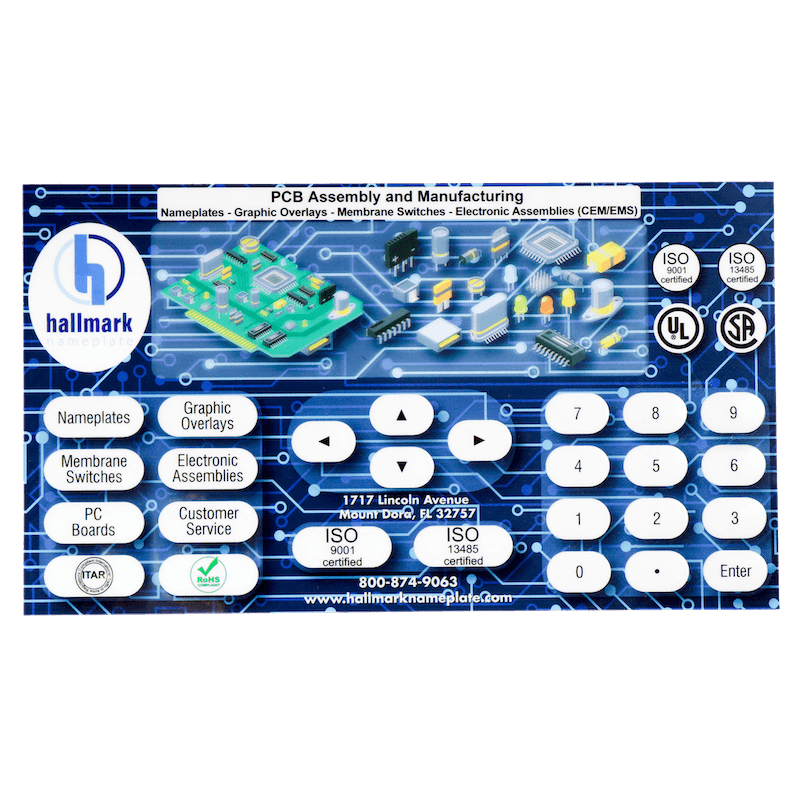How Membrane Switch Technology is Revolutionizing User Interfaces
How Membrane Switch Technology is Revolutionizing User Interfaces
Blog Article
Comprehending Membrane Layer Switches Over: The Secret to Durable and Reliable Controls

What Are Membrane Switches?
Membrane switches are an innovative service in the world of interface modern technology, integrating capability and design seamlessly. These tools act as a user interface in between individuals and digital systems, incorporating several parts right into a portable style. Commonly created from adaptable, thin layers of materials, membrane layer switches are designed to respond to touch, allowing individuals to engage with equipment and electronic gadgets effectively.
The primary aspects of a membrane button include a published circuit layer, visuals overlay, and a spacer layer that prevents unplanned activation. The graphic overlay can be customized to reflect brand name identification or customer preferences, improving visual appeals while ensuring use. Membrane switches are generally utilized in various applications, consisting of medical tools, consumer electronics, and commercial equipment, owing to their resilience and resistance to environmental aspects such as wetness and dirt.
One of the vital advantages of membrane switches is their ability to withstand wear and tear, making them excellent for high-traffic atmospheres. In addition, they are light-weight and need minimal room, enabling cutting-edge layouts in item growth. On the whole, membrane switches stand for a effective and functional option for modern digital user interfaces, weding technology with user-centric style principles.
Exactly How Membrane Layer Changes Job
The procedure of membrane switches hinges on a basic yet effective mechanism that converts individual input into digital signals. These buttons contain numerous layers, normally including a graphic overlay, a spacer layer, and a circuit layer. When a user presses the switch, the top layer deforms, enabling a conductive aspect in the circuit layer to make contact with a matching conductive pad on the bottom of the graphic overlay. This contact shuts the circuit and sends out a digital signal to the gadget, suggesting that the button has been triggered.
The layout of membrane layer switches can vary, however they often include domes or responsive components to provide feedback to the individual, improving the general experience - membrane switch. The materials used in membrane switches, such as polyester or polycarbonate, add to their sturdiness and resistance to environmental aspects, consisting of wetness and dirt. The printed circuits are usually enveloped, which secures them from wear and tear over time.
Advantages of Membrane Layer Buttons

Additionally, membrane switches are known for their sturdiness. Constructed from durable materials, they are immune to dust, moisture, and physical wear, which significantly expands their lifespan contrasted to conventional mechanical buttons. This resilience makes them specifically ideal for high-traffic environments and applications needing longevity.
Another considerable advantage is the simplicity of cleansing and maintenance. The smooth surface area of membrane changes lessens dirt accumulation and is frequently resistant to spills, making them ideal for setups that need frequent sanitization.
Moreover, membrane layer switches use a streamlined profile, resulting in a thinner design that can be incorporated right into various devices without including mass. This function not only enhances the aesthetic appeal yet additionally contributes to a more ergonomic item style.
Applications of Membrane Switches
Straightforward and flexible, membrane layer switches locate applications across a vast array of markets, consisting of medical devices, consumer electronic devices, and commercial tools. In the medical field, these buttons are important to devices such as diagnostic devices, client surveillance systems, and mixture pumps, where dependability and convenience of cleansing are essential. Their ability to preserve and stand up to severe atmospheres capability makes them suitable for this content such applications.

In consumer electronic devices, membrane layer buttons are utilized in products like microwaves, washing machines, and remotes - membrane switch. Their smooth layout permits for user-friendly interface, boosting the overall user experience while supplying resilience and resistance to damage
Industrial devices additionally takes advantage of membrane buttons, particularly in control panels for equipment and automation systems. These buttons offer protection against dirt and moisture, guaranteeing constant efficiency in tough atmospheres. Their personalized features permit makers to tailor them to certain functional requirements, improving performance and functionality.
Selecting the Right Membrane Layer Switch
When choosing a membrane button, it is important to consider numerous variables that affect performance and suitability for specific applications. The primary considerations include ecological problems, tactile feedback, durability, and style requirements.
First, examine the operating environment; switches revealed to moisture, chemicals, or extreme temperatures call for particular products to make sure long life and functionality. Next, examine the need for responsive responses. Depending on user communication, some applications may take advantage of a responsive response to verify activation, while others might favor a non-tactile design for visual factors.
Resilience is an additional vital factor; membrane buttons need to be made to withstand constant use, effects, and abrasion. Make certain the selected button can sustain the expected lifecycle, specifically in high-usage scenarios.

Final Thought
In verdict, membrane layer changes serve as essential parts in the style this link of dependable and long lasting control systems throughout numerous industries. The adaptability of membrane layer switches enables for customized services that fulfill specific operational requirements, reinforcing their relevance in contemporary technology.
Membrane changes represent a vital aspect of modern-day user interface design, mixing capability with resilience in numerous applications.Membrane buttons are an innovative remedy in the world of user interface technology, integrating functionality and layout seamlessly. Commonly built from versatile, thin layers of products, membrane layer buttons are developed to respond to touch, allowing individuals to connect with equipment and electronic gadgets successfully.
The style of membrane layer buttons can vary, yet they frequently incorporate domes or responsive aspects to supply comments to the important source user, enhancing the total experience.In final thought, membrane switches offer as vital parts in the style of reputable and long lasting control systems throughout numerous markets.
Report this page